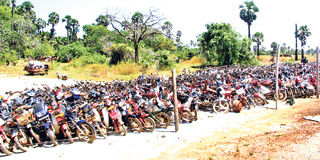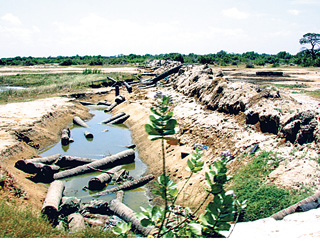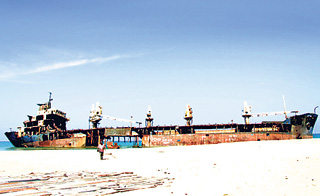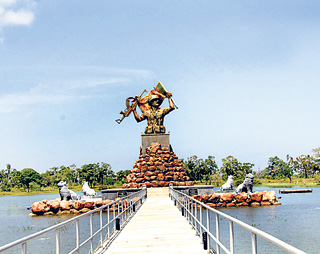Both sides of the A9 highway are studded with remains of war. Bombed out houses with bullet marks, scorched trees, bunkers and danger signs in red plastic straps warning 'mines: do not cross'. Along the way, there are many army posts and two checkpoints where vehicles are searched and identities confirmed. As dusk falls, army personnel with rifles slung over their shoulders begin short patrols on the highway.
Outside empty towns herds of abandoned cattle aimlessly roam. These aimless cows are possibly the biggest danger to the hundreds of buses, vans and trucks that now ply the A9 to Jaffna. For decades Jaffna was isolated (except an expensive air link and circuitous sea route) as the highway was closed to civilians. In January, restrictions were lifted.
Till last year, the A9 carried with it the burden of a bloody war; now it’s uneven, potholed surface carries busloads of tourists and trucks full apples and oranges to Jaffna in the north. The distance between Jaffna, at the heart of Sri Lankan Tamil identity, and Kandy, the religious and historical capital of the country’s Buddhist-Sinhalese majority is the 321 km-long highway.
For a better part of the last 27 years, the A9, built by the British in the late 19th century, separated the two entities more than bridging them. Towards the north, the LTTE controlled the highway and swathes of land on either side. Till 2008, the LTTE and the Sri Lankan army (SLA) exchanged bodies of dead combatants at a village called Omanthai on the highway as the International Committee for the Red Cross (ICRC) kept watch.
The SLA and the LTTE fiercely fought to control the road through the 1990s. ``Sometimes the distance would be measured in casualties; like 45 every km. The SLA had launched one its longest operations `Jayasikuru’ (definite victory), in 1997 to gain control of the highway. It was discontinued after heavy casualties,’’ an army officer said. Along the A9 is Kilinochchi, once the LTTE’s administrative capital where chief V Prabhakaran addressed his only press conference in 2002.
In January 2009, the SLA brought the highway under its control in decades.
A year later, northern parts remain war-ravaged. Near Elephant Pass – an expanse of blinding salt fields, the gateway to the Jaffna peninsula – there is a cluster of trees stumps, a literally stark reminder of relentless air-raids by the Sri Lankan air force.
Down the road is a dumped road-roller converted into an armoured vehicle by the LTTE. Now decorated with garlands, tourists from the south pose victoriously in front of it.
There are some signs of life in Kilinochchi. Small shops selling provisions have opened for the displaced who have returned. At the bus-stand, a dozen Tamil displaced wait for buses and their mobile phones to get recharged at a communal phone-charging station. From a nearby kiosk, a Sinhala song is blasting; a change from the all-Tamil signage which remains on crumbling shops.
South of Vavuniya, a Tamil-dominated town which always remained under government control, the vegetation gradually changes, and so does the population. It becomes almost wholly Sinhalese.
Nandikadal revisited
By Hiran Priyankara Jayasinghe in Wellamullivaikkal, Mullaitivu

Around 10,000 motor cycles and 25,000 bicycles belonging to LTTEers and civilians who fled, are seen stacked in the Wellimulliwaikkal and Nandikadal areas and other areas in the Mullaitivu district.
They, together with the innumerable ruined abodes ranging from what were once thatched cottages to well built houses, remain as the legacy of the three decade old war.
 The region bears tell tale marks of the war that was fought fiercely between the LTTE and Government forces. Remains of military vehicles such as bullet proof trucks and jeeps still lie around.
The region bears tell tale marks of the war that was fought fiercely between the LTTE and Government forces. Remains of military vehicles such as bullet proof trucks and jeeps still lie around.  The Jordanian ship MV Farah 111 that ran aground off the Mullaitivu coast. This ship was used by the LTTE to fire from in a last ditch battle
The Jordanian ship MV Farah 111 that ran aground off the Mullaitivu coast. This ship was used by the LTTE to fire from in a last ditch battleHerds of cattle are still to be seen reminding us that villages once existed in these areas. The security forces are still in the process of de-mining with the aid of equipment received from a number of countries. Places like Puthukudiyiruppu, Viswamadu, and Putumattalan which were the central areas where the war was fought, are still out of bounds to the public due to the area being infested with mines and permission has to be obtained from the defence authorities to gain access to the area.

A victory memorial has been put up in Puthukudiyiruppu captured by the 53 and 58 Divisions of the Army. Names of all regiments that took part achieving this victory are inscribed on this memorial. A monument to mark the spot where LTTE leader Velupillai Prabhakaran fell is being erected by the security forces.
No comments:
Post a Comment